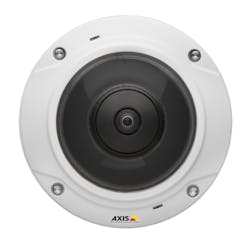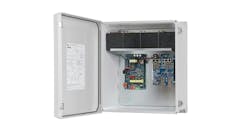Locksmiths have traditionally teamed with school and university facility departments and administrators to achieve ever improving security management policies and infrastructure.
It is an undeniable fact the good security management is a multi-disciplinary art and a science. Unfortunately current events reveal that with respect to protecting our children, there is no simple security solution to prevent every type of tragedy.
Traditionally physical security was construed to involve secured openings and locking devices. However, far more effective results are obtained with the integration of strong physical security with access control and video surveillance. Their combined success depends upon each element working together interactively.
Time to respond to a perceived threat counts as a priority ingredient in all security, and new video surveillance technologies and equipment offer the opportunity to make substantial improvements in student survival rates. The early detection that wide and close-in perimeter surveillance can provide has been proven to be a solution.
Locksmiths are ideally situated in the technology channel to fulfill these essential products and services. New developments in video surveillance technology based on IP technology are helping improve security in schools, while enhancing operations throughout the facility. Compared to analog, IP-based solutions are much more versatile, produce much better images and offer a lower overall cost of ownership.
For many educational institutions, this shift from traditional analog technology to open platform IP video surveillance comes at a perfect time. Most schools already have the necessary IP network infrastructure in place and IP video surveillance can make the most of their budgets now and in the future.
Locksmith Ledger is showcasing two providers in the video surveillance market. AXIS offers IP camera technology, and WavestoreUSA develops software to manage the cameras.
Axis Technologies
Locksmith Ledger reached out to AXIS’ Vince Ricco, Business Development Manager, Technology Partner Program for AXIS. Following are Ledger’s questions and Ricco’s answers.
What is the status and short-term forecast for the video security industry especially as it applies to the education market?
The education market was an early adopter of IP video technology, and there continues to be a heightened awareness of school safety and security among parents, schools and local and federal government that will continue to drive the market. In addition, more funding dedicated to greater real-time threat assessment and security measures will impact the use of video. We see, particularly in the case of K-12 education, a greater involvement and support by the districts’ IT departments in the addition of IP-based surveillance and access control systems, where as previously facilities had a key role in earlier generation analog systems.
What differentiates each group? How do you define the different market segments?
While all of education falls under the header of “Education Segment” within Axis, it is important to understand the key differences between K-12 and higher education. While higher education typically has a safety and security department or division, in many cases K-12 is relying on a combination of facilities and IT to provide the physical security solutions for the district. We are often working within a framework or specification to provide the best solution to higher education, while with K-12 we work in a more advisory or consultative role, particularly due to constrained resources within public school districts.
Which of your products are best suited for the education market. Why?
There is no one-size-fits-all solution, which is why Axis offers the industry’s broadest product portfolio. Many factors affect camera selection, from placement to purpose to lighting. However, here are some trends that we see of interest to schools.
- Indoor vandal-resistant cameras
- 360-degree cameras for overviews of large areas, such as auditoriums, lunch rooms, gyms and playgrounds
- 360-degree single lens cameras that are wall-mounted to provide a 180-degree image in hallways
- Pan/tilt/zoom (PTZ) cameras for parking lot surveillance
- For sports stadiums, thermal cameras can provide perimeter protection around fence lines
- Access control in classrooms, storage rooms and ingress/egress points
What tools, products and support does AXIS offer to security professionals for this market (pre-sales, system design, deployment, system management?)
Axis is dedicated to educating the industry and providing the tools needed for success. It truly starts with education, and Axis Communications’ Academy (http://www.axis.com/academy/) offers both online and classroom trainings on a variety of topics within sales and business, system design and installation and configuration. The Axis Certification Program allows individuals to verify and validate their knowledge and expertise of surveillance solutions.
Axis also offers a variety of online design tools, including a product selector and bandwidth / storage calculator. Axis Camera Extension for SketchUp 3D CAD software, Axis Camera Families for Autodesk Revit and Axis Coverage Shapes for Microsoft Visio are all available to help design and specify a surveillance system. All nine installation tools can be found here: http://www.axis.com/techsup/system_design_tools/index.htm.
AXIS Camera Management (http://www.axis.com/en/products/cam_mgmt_software/index.htm) is a powerful and efficient installation and management tool and allows for one-console management of Axis cameras from IP addressing to user privileges to cyber security settings. The software can be used for maintenance of cameras: applying firmware upgrades, save and backup template of camera configuration and inventory management.
Axis is committed to partnership and works closely with the industry’s largest professional network to deliver complete solutions for any end user need. More info can be found about these programs at the following links:
- Axis Application Development Partner (ADP) Program: http://www.axis.com/partner/adp_program/index.htm
- Axis Technology Partner Program: http://www.axis.com/partner/tpp/index.htm
- AXIS Camera Application Platform: http://www.axis.com/techsup/cam_servers/dev/application_platform/
- Axis Architecture & Engineering (A&E) Program: http://www.axis.com/partner/consult/index.htm
On an upgrade, is it wiser to integrate with the existing system or add on a new one?
Upgrade philosophy depends heavily on two factors: funding and ability to re-cable. Though ideal, end-to-end upgrades are not always feasible. Fortunately, there are two paths to upgrade outside of end-to-end replacements.
Example 1: The existing cabling and cameras are still used but converted to IP by way of video encoders.
This can be done by using a one-to-one conversion more common in small systems or by using multiple analog in to single IP out encoders. In larger migration deployments, a chassis based system can be used to convert groups of analog cameras over coax to one or several Ethernet IP out connections to the MMS servers. In these instances, the camera is still transmitting analog signals over the existing coax cabling and then converts this to a digital stream within the encoder. This actually allows for an enhancement of the video through algorithms and actually allows for use of video analytics to be applied to the video content.
Example 2: Allows for use of the existing coax cabling but enables immediate implementation of IP cameras into the system.
This is done by using Ethernet over Coax media conversion. Power over Ethernet (PoE) can even be achieved of the existing coax by first verifying the coax specification supports the PoE requirements and then adding the appropriate book end conversion devices. Axis allows this to be achieved as a one-to-one camera to converter system or by chassis solutions. Axis’ current encoder chassis allow for a blade replacement to go from encoding (analog to IP conversion) to media conversion (IP cameras running off of existing coax) thus protecting the chassis investment and allowing for an even more migratory approach to upgrading analog to IP.
More info about encoders: http://www.axis.com/products/video/video_server/index.htm.
Do you have an app and is it a sales tool or for clients to manage view their systems?
For mobile apps, we have the following:
- AXIS Guide: http://www.axis.com/products/video/selector/axis_guide.htm
- AXIS Mobile Viewer for Hosted Video: http://www.axis.com/hosting/mobile_app.htm
- AXIS Camera Companion mobile viewing app: http://www.axis.com/products/cam_companion_software/mobile_app.htm
WavestoreUSA
The WavestoreUSA Video Storage and Management System is based on an open platform capable of incorporating both IP network cameras and a school's existing analog cameras. For the locksmith, the WavestoreUSA digital Video Storage and Management System integrates seamlessly with an electronic access control system to tie functions into the video like an audit trail and for management of who is entering and exiting a building.
Mike Scirica, President, WavestoreUSA, answered the Ledger’s questions about his products and their relevance to school security.
What products and services do you offer?
WavestoreUSA offers open platform digital video storage and management systems for security, surveillance and business optimization. A wide variety of configurations are available based on the number of cameras, amount of storage and length of recording required.
With WavestoreUSA you get a professional solution at an affordable price with the power to upgrade and expand. A complete turnkey system that fits any application, all WavestoreUSA Video Storage and Management Systems are pre-loaded with feature-rich Wavestore V5 Video Management Software; combining storage with the server and the management software. The video management software functions in new and different ways beyond what was originally intended.
Which features are used in the school security sector?
Some of the features of the WavestoreUSA Video Storage and Management System relative to school security include:
• Seamless integration with other hardware and software security systems (building management, access control, point of sale applications) and a single point of control.
• Lower total cost of ownership with super-efficient and stable Linux-based servers plus versatile, license free Windows clients. Our systems are purpose-built and optimized for high resolution, high framerate and long term storage.
• Easy and cost-effective expansion as needs grow.
• Future-proof with the ability to add new innovations as they become available.
Product compatibility is not an issue. Being ONVIF Profile S conformant, our Video Storage and Management Systems support virtually all analog, IP, HD-SDI and megapixel surveillance solutions, including 360-degree fisheye and night vision cameras. Combined with our integration capabilities, you are not tied into one manufacturer’s products and are free to choose the best of breed components that are the most suitable for the application. Systems are flexible and extremely easy to use.
What differentiates your product from your competitors?
WavestoreUSA has a proven track record of providing high tech surveillance solutions for over a decade. A groundbreaking approach to video management, Wavestore V5 Video Management Software incorporates the most up to date video surveillance technology and the latest innovations. Wavestore V5 is constantly setting new standards. The V5 Video Management Software is easy to install, configure, operate and upgrade.
By combining the storage with the server components and offering them as a turnkey solution, our systems are less expensive, easier to install and less costly to maintain. Our dewarping technology surpasses the industry norm. Built-in client dewarping functionality simultaneously displays multiple dewarped images from any industry 360-degree fisheye camera stream, while a virtual PTZ allows operators to view enlarged portions of the total image for complete surveillance coverage using fewer cameras. The ability to dewarp 360-degree images into standard views can be done with live views, recorded views or even from backups.
WavestoreUSA markets exclusively to the security dealer/integrator channel. WavestoreUSA’s products are assembled in the United States and optimized for the American security market, providing the confidence of knowing that WavestoreUSA solutions will perform as specified and meet the rigors of even the most challenging vertical applications.
In what situations is your product most cost-effective?
Typically the two most expensive elements of a video surveillance/security system are the costs of cameras (and installation) and the cost of storage (hard drives). The WavestoreUSA Video Storage and Management System is based on an open platform capable of incorporating both IP network (digital) cameras and a school's existing analog cameras creating cost effective hybrid that is scalable for future expansion and ideal for growing a system as budget allows. We support all of the industry 360-degree fisheye cameras which, when deployed, can significantly lower the number of cameras needed. Our systems incorporate a proprietary storage method (LASS) and we are compression agnostic; we can simultaneously display and record multiple different compression methods (H.264, MPEG-4, MPEG-2, MJPEG and even MxPEG).
An open platform IP video storage and management system from WavestoreUSA can grow and evolve with a school's needs and could last for a long time without having to spend additional funds for video surveillance. One of our system integrators recently deployed a WavestoreUSA storage and management server that is using new 4K resolution cameras, with no modifications or assistance from us; the system deployed as expected. Cost effective and efficient system architecture provides optimum operational life over long periods of time, with additional manpower savings on training and reduced site visits with remote system diagnostics and maintenance.
What is the minimum camera count suggested?
Different models are available that handle as few as four cameras and up to 16 cameras and our Enterprise models accept up to 128 cameras or more. Because we support HD, full HD, megapixel and 180- and 360-degree cameras, you can provide more coverage with fewer cameras so it’s become somewhat less important how many cameras versus what type of cameras.
Are there any constraints on camera type used?
We are ONVIF Profile S conformant; ONVIF is an open industry forum for the development of a global standard for the interface of IP-based physical security products. We also have custom drivers for over 50 manufacturers’ IP network cameras. These custom drivers provide additional functionality, improved performance or added benefits over and above ONVIF which is still maturing. We continually develop new drivers and add to our extensive list of support devices. We aggressively pursue new integrations and provide them quickly.
What are the cost/benefits of a 360 with your product as compared to several fixed cameras? as compared to a P/T/Z?
180- and 360-degree cameras provide coverage for larger areas, reducing the total number of cameras required while increasing efficiency of the operators. Fewer cameras reduce deployment costs and most 180 and 360-degree cameras are PoE so a single cable supports power, video, audio, I/O and events.
Multiple “virtual” camera views can be created from a single stream so the operator has conventional fields of view but these views can be changed on the fly with a digital/electronic pan and tilt function.
Since there are no moving parts, the long term maintenance hassle of a conventional PTZ is avoided.
And because we record and store the original 180-degree or 360-degree view you cannot be looking the wrong way like a motorized p/t/z. Operators are not required to switch between cameras as often and no operator intervention is required to set up the exact viewing angle. Once again, the view can be adjusted after-the-fact.
What training is required?
We offer three levels of training, including an end-user train-the-trainer program, dealer training and certified integrator training. We also provide sales training. We pride ourselves in our training and additional information is available via www.wavestoreusa.com.
Tim O'Leary
Tim O'Leary is a security consultant, trainer and technician who has also been writing articles on all areas of locksmithing & physical security for many years.






